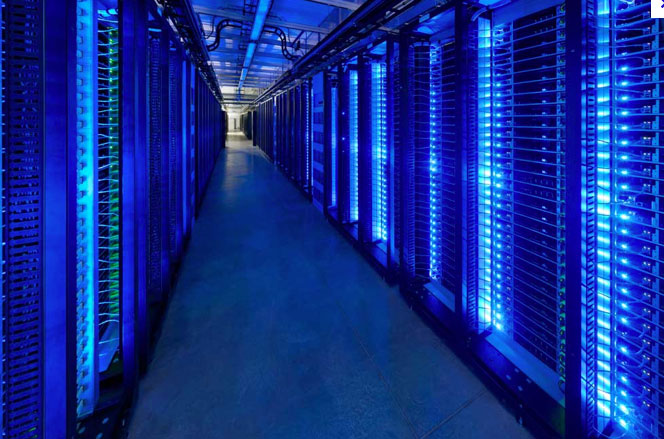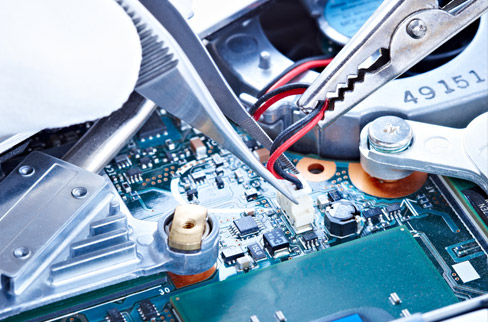News
- GNOME 3.6 for Linux and Unix desktop released
- Intel's new Itanium chip, Poulson, to launch later this year
- Has the mystery of Stonehenge's purpose finally been solved?
- IBM drops Power7+ in high-end Unix servers
- Solaris Unix operating system updated by Oracle
- Leading Browser-based Terminal Emulator Provides Secure Web-based Access to Unix Systems.
IBM drops Power7+ in high-end Unix servers
The Power7+ is coming first to IBM's Power 770 and 780 systems, and runs at a maximum of 4.4GHz
IDG News Service - IBM has started to roll out a new processor for its Power family of servers, a staggered affair that will start with higher-end systems and eventually reach the midrange and low-end boxes.
The new Power7+ chip has a higher clock speed than its predecessor, at up to 4.4Ghz, but the biggest change is in the Level 3 on-chip memory cache, which IBM has expanded to a sizeable 80MB, from 32MB on the Power7.
The bigger cache means more of the data being used for calculations -- the "working set" -- can be stored on the chip close to the CPU cores, which helps to speed operations. With a smaller cache, data has to be fetched more frequently from main memory.
The higher clock speed and larger cache will give a boost in performance for databases and Java applications, according to Satya Sharma , CTO for IBM's Power Systems business and an IBM "fellow," or one of its top engineers. "We can improve performance for some Java applications by up to 40 percent compared to the Power7," Sharma said.
IBM's top brass are due to discuss its systems business during a customer webcast at 11 am Eastern Wednesday. They may also talk about a new, high-end storage system called the DS8870 and an update to IBM's DB2 Analytics Accelerator, which are also being announced.
Across the country at about the same time, Oracle systems chief John Fowler is due to give a keynote speech at Oracle OpenWorld in San Francisco, and Hewlett-Packard is holding its financial analyst day, where it's sure to give an update on its systems strategy.
None of the vendors have a lot to cheer about, at least when it comes to Unix: Unix systems revenue dropped 20 percent in the June quarter, to $2.3 billion, according to recent figures from IDC. But at least IBM's revenue declined only 10 percent, and it managed to gain 6.1 points of market share, IDC said.
The Power7+ is being offered now for the Power 770 and 780 systems, which sit near the high-end of the Power line-up. It will come eventually to lower-end systems as well, like the 740 and 750, but IBM isn't saying yet when that will be.
IBM's most powerful Unix machine, the Power 795, won't get the new chip at all, Sharma said. Customers that buy such high-end systems generally prefer stability to incremental upgrades, he said, adding that IBM took the same tack when it introduced the Power 6+.
The 795 will get at least one technical boost, however. IBM is introducing a new memory module with twice the density, so the maximum configuration for the 795 increases from 8TB of main memory to 16TB. The 770 and 780 also get the denser DIMMs.
IBM is also introducing a new memory compression accelerator that can "make a 32GB system look like a 48GB or 64GB system," Sharma said. That can help reduce memory costs for customers, but there's a trade-off in increased latency as data is decompressed for use.
With the Power7+, IBM has also doubled the number of virtual machines customers can run on each processor core, to 10 VMs. While customers might not want that many virtual machines for production use, developers can use them for jobs like compiling code, Sharma said.
Another feature that's been discussed with the Power7+ -- the ability to put two processors in one socket -- also isn't available yet. The DCM, or Dual Chip Module, effectively increases the operations per second that customers get from each socket, with the trade-off that the cores run at lower clock speeds.
It's not being offered for the high-end Power systems machines, however. "It's partly that there is a little bit more work to do, and partly it's the class of systems where we want to use that capability," Sharma said. He wouldn't give details but implied the technology is destined for midrange or lower-end systems like the Power 740 and 750.
IBM offers a sort of "compute on demand" scheme for its Power systems, through which customers can pay to activate additional processor cores for a few weeks or months, such as during the holiday shopping season, then disable again them afterwards.
It's running a "special offer" for customers who buy a new 780 or 795 system. For each processor that ships with the server, they get 15 days of additional processing for free. So if a customer buys a Power 780 system with 16 cores enabled, they also get 15 days when they can turn on an additional 16 cores.
It's also introducing a concept called Power System Pools, which lets customers use those 15 days -- and any other compute days they purchase -- across up to 10 different 780 or 795 servers. Essentially it gives customers more flexibility in how they allocate their processor resources, and, IBM hopes, makes them a bit more likely to choose IBM.
IBM doesn't usually publish prices for such high-end systems but the faster chips will come in at about the same price point as their predecessors, Sharma said. It will offer slightly better pricing on the Power 780 because it would prefer more customers bought its higher-end systems, he said.
IDG News Service - IBM has started to roll out a new processor for its Power family of servers, a staggered affair that will start with higher-end systems and eventually reach the midrange and low-end boxes.
The new Power7+ chip has a higher clock speed than its predecessor, at up to 4.4Ghz, but the biggest change is in the Level 3 on-chip memory cache, which IBM has expanded to a sizeable 80MB, from 32MB on the Power7.
The bigger cache means more of the data being used for calculations -- the "working set" -- can be stored on the chip close to the CPU cores, which helps to speed operations. With a smaller cache, data has to be fetched more frequently from main memory.
The higher clock speed and larger cache will give a boost in performance for databases and Java applications, according to Satya Sharma , CTO for IBM's Power Systems business and an IBM "fellow," or one of its top engineers. "We can improve performance for some Java applications by up to 40 percent compared to the Power7," Sharma said.
IBM's top brass are due to discuss its systems business during a customer webcast at 11 am Eastern Wednesday. They may also talk about a new, high-end storage system called the DS8870 and an update to IBM's DB2 Analytics Accelerator, which are also being announced.
Across the country at about the same time, Oracle systems chief John Fowler is due to give a keynote speech at Oracle OpenWorld in San Francisco, and Hewlett-Packard is holding its financial analyst day, where it's sure to give an update on its systems strategy.
None of the vendors have a lot to cheer about, at least when it comes to Unix: Unix systems revenue dropped 20 percent in the June quarter, to $2.3 billion, according to recent figures from IDC. But at least IBM's revenue declined only 10 percent, and it managed to gain 6.1 points of market share, IDC said.
The Power7+ is being offered now for the Power 770 and 780 systems, which sit near the high-end of the Power line-up. It will come eventually to lower-end systems as well, like the 740 and 750, but IBM isn't saying yet when that will be.
IBM's most powerful Unix machine, the Power 795, won't get the new chip at all, Sharma said. Customers that buy such high-end systems generally prefer stability to incremental upgrades, he said, adding that IBM took the same tack when it introduced the Power 6+.
The 795 will get at least one technical boost, however. IBM is introducing a new memory module with twice the density, so the maximum configuration for the 795 increases from 8TB of main memory to 16TB. The 770 and 780 also get the denser DIMMs.
IBM is also introducing a new memory compression accelerator that can "make a 32GB system look like a 48GB or 64GB system," Sharma said. That can help reduce memory costs for customers, but there's a trade-off in increased latency as data is decompressed for use.
With the Power7+, IBM has also doubled the number of virtual machines customers can run on each processor core, to 10 VMs. While customers might not want that many virtual machines for production use, developers can use them for jobs like compiling code, Sharma said.
Another feature that's been discussed with the Power7+ -- the ability to put two processors in one socket -- also isn't available yet. The DCM, or Dual Chip Module, effectively increases the operations per second that customers get from each socket, with the trade-off that the cores run at lower clock speeds.
It's not being offered for the high-end Power systems machines, however. "It's partly that there is a little bit more work to do, and partly it's the class of systems where we want to use that capability," Sharma said. He wouldn't give details but implied the technology is destined for midrange or lower-end systems like the Power 740 and 750.
IBM offers a sort of "compute on demand" scheme for its Power systems, through which customers can pay to activate additional processor cores for a few weeks or months, such as during the holiday shopping season, then disable again them afterwards.
It's running a "special offer" for customers who buy a new 780 or 795 system. For each processor that ships with the server, they get 15 days of additional processing for free. So if a customer buys a Power 780 system with 16 cores enabled, they also get 15 days when they can turn on an additional 16 cores.
It's also introducing a concept called Power System Pools, which lets customers use those 15 days -- and any other compute days they purchase -- across up to 10 different 780 or 795 servers. Essentially it gives customers more flexibility in how they allocate their processor resources, and, IBM hopes, makes them a bit more likely to choose IBM.
IBM doesn't usually publish prices for such high-end systems but the faster chips will come in at about the same price point as their predecessors, Sharma said. It will offer slightly better pricing on the Power 780 because it would prefer more customers bought its higher-end systems, he said.
Enquire Today
To discuss your requirement please contact us direct on
+44 (0) 208-604-8886 ,
email sales@gcbuk.com or fill in the form below and we will call you back. Fields marked with a * are mandatory.







